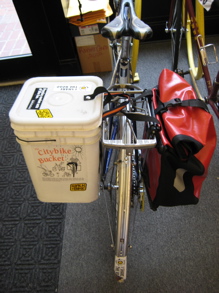A deadline for the League of American Bicyclists "
Bicycle Friendly Community" renewal is next month on February the 11th. I believe this year marks Salem's four-year renewal cycle - though we may be on the August submission rather than the February deadline. We were rated in the fall of 2008 and 2012, and 2016 marks another four years.
So where are we?
The assessment is really bifocal. On the one hand, by national standards and in the near focus, Salem remains a relatively good place to bike. There are tons of communities out there that lack a basic network of sidewalks and bike lanes, has never heard of a sharrow, lacks any interest in things like the Union St. RR Bridge and the Courtney Minto Bridge, and doesn't even try to pay lip service to any notions of "balance" and "multi-modal" planning.
By these standards it would be surprising for Salem to lose Bronze, I think. By these standards Salem does a good job. Not a Silver, Gold, or Platinum job, but a Bronze job, an effort of very real, though minor, distinction.
But on the other hand, by absolute standards and looking out farther, by the extent to which we measure up to our ideals and goals, I would say we're mired in a pretty lousy state.
Salem's commitment to 1980s style bike lanes on busy streets rated as arterials and collectors means our network really only serves the "experienced and confident." That hunched over, almost certainly male, rider on the far right of the typology at top.
(An actual designer would manage the diagramming mash-up, but you get
the idea: Our "Bronze" serves only one end of the spectrum.)
The network intermittently serves some of the "casual and somewhat confident," and pretty much utterly fails the "interested but concerned." They're stuck doing loops out at Minto Park and annoying the bird watchers and dog walkers. In an important way, our failure on the streets exacerbates user conflicts in the parks.
We're still working on a real Bicycle Boulevard in the Winter-Maple project, we're hoping for a real buffered bike lane on South Commercial in the Commercial-Vista project, we're still working on access to the Union St Railroad Bridge at the difficult crossings of Commercial and Wallace, and so on.
As far as
specific recommendations from 2008 and 2012 go, we have made real progress on few of them. So there aren't grounds for an upgrade there, either.
(The LAB also has a few areas of emphasis that we might also disagree with some.)
So it would be nice to maintain our "Bronze" rating, but it also no longer seems like anything worth crowing about. It's nice, but not super relevant. It's a pleasant afterthought rather than mark of core commitment. As a "carrot," whose aim is to encourage a greater civic commitment to bike transport, doesn't seem to lead to much more than the default conditions. So, we'll see how it turns out this fall.



















































